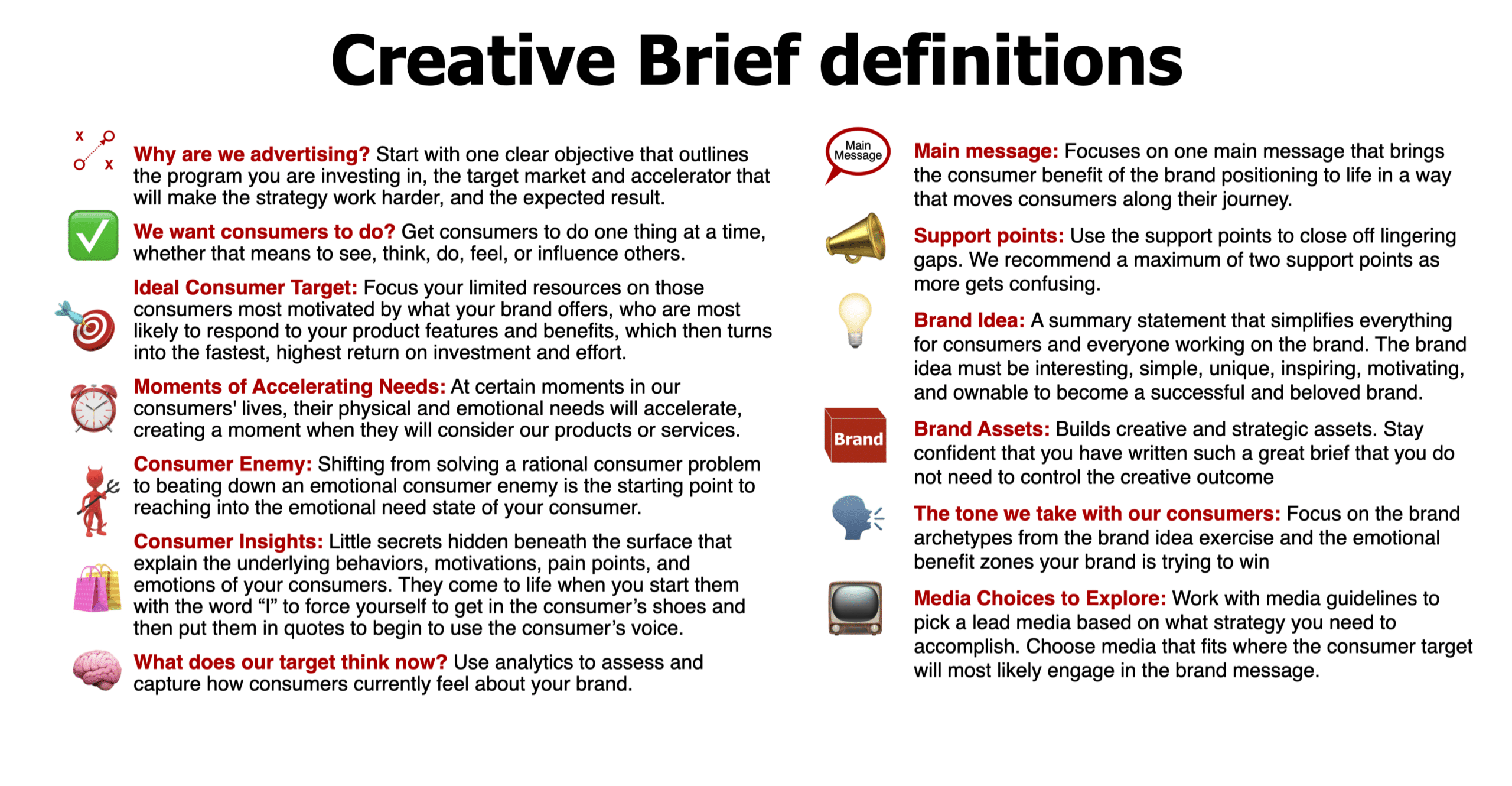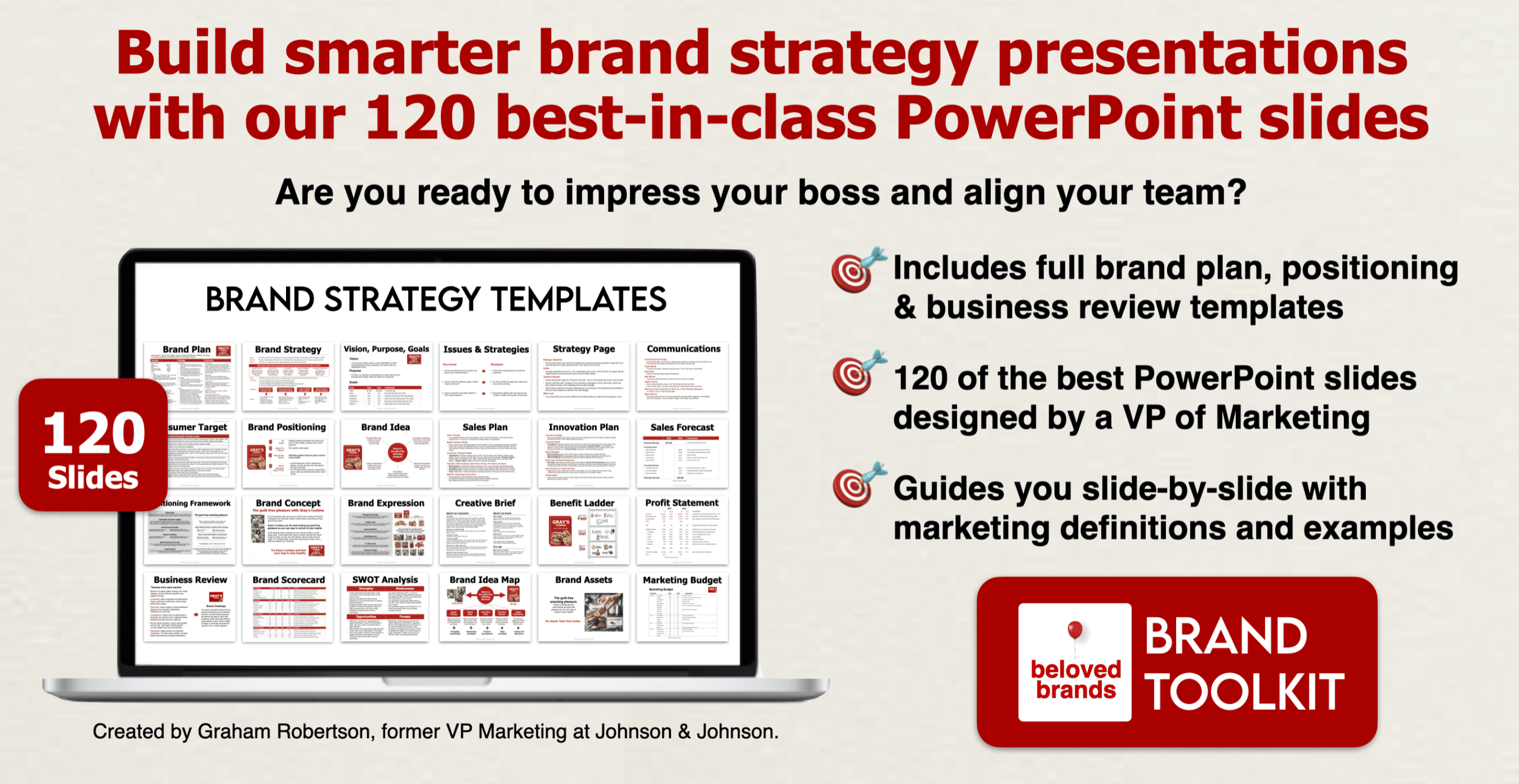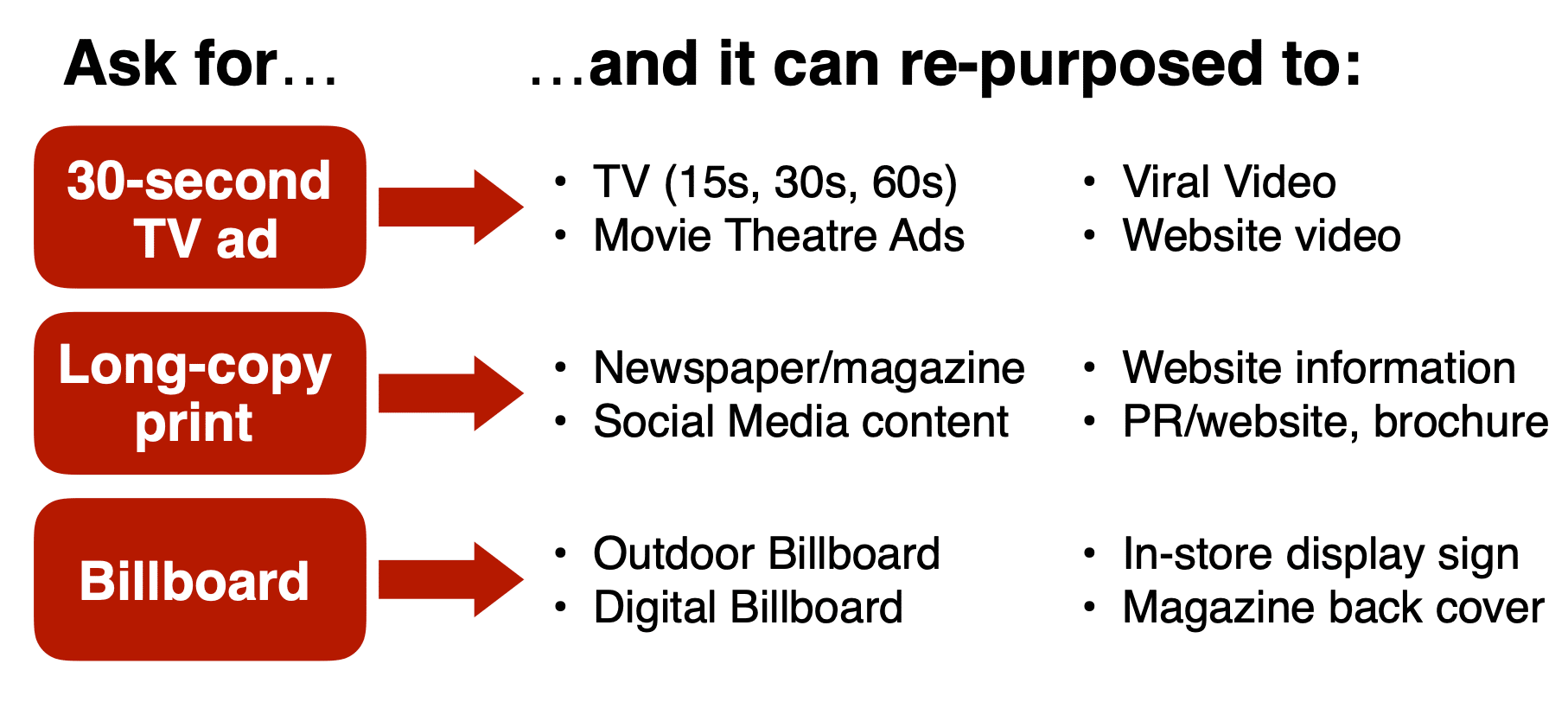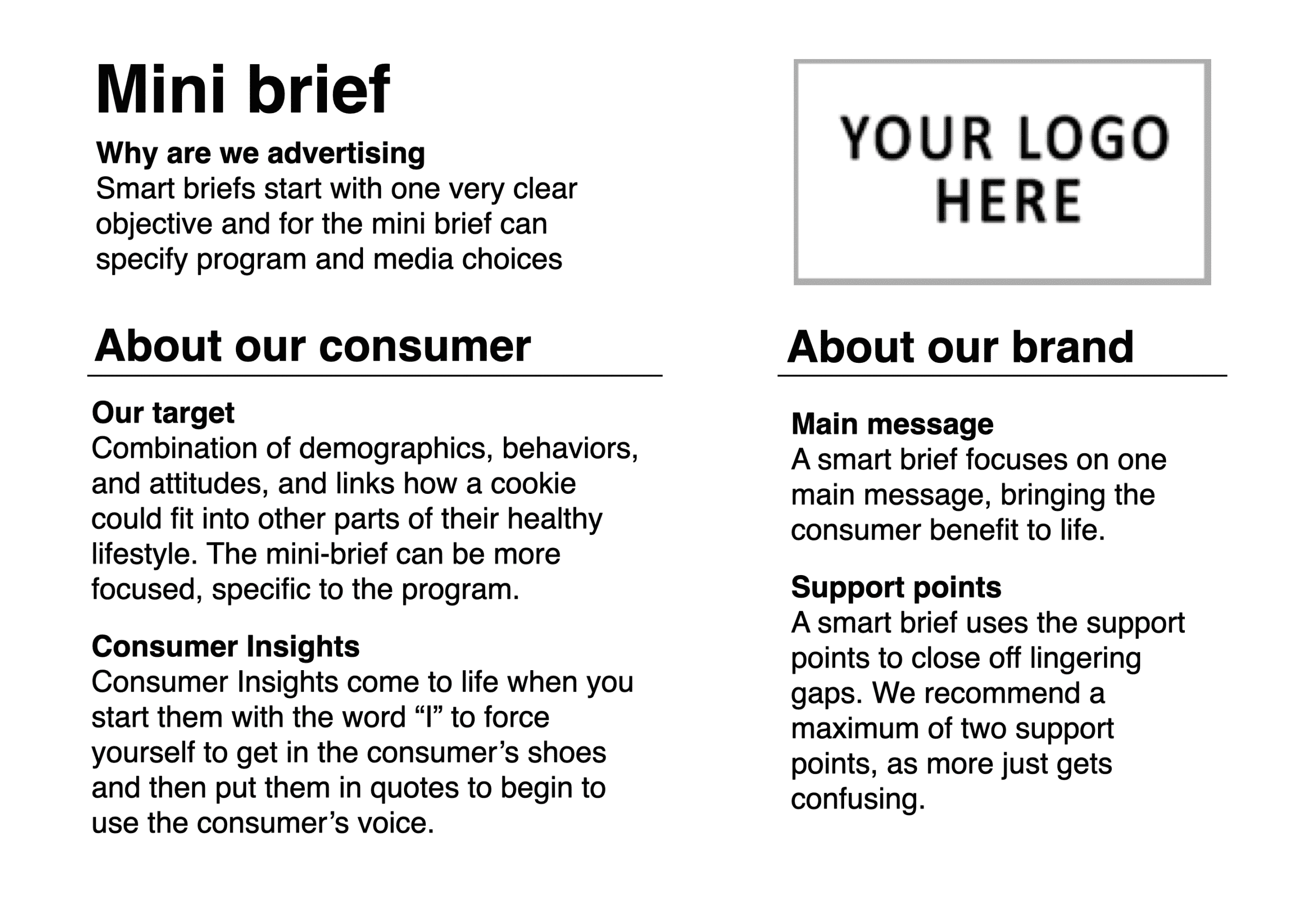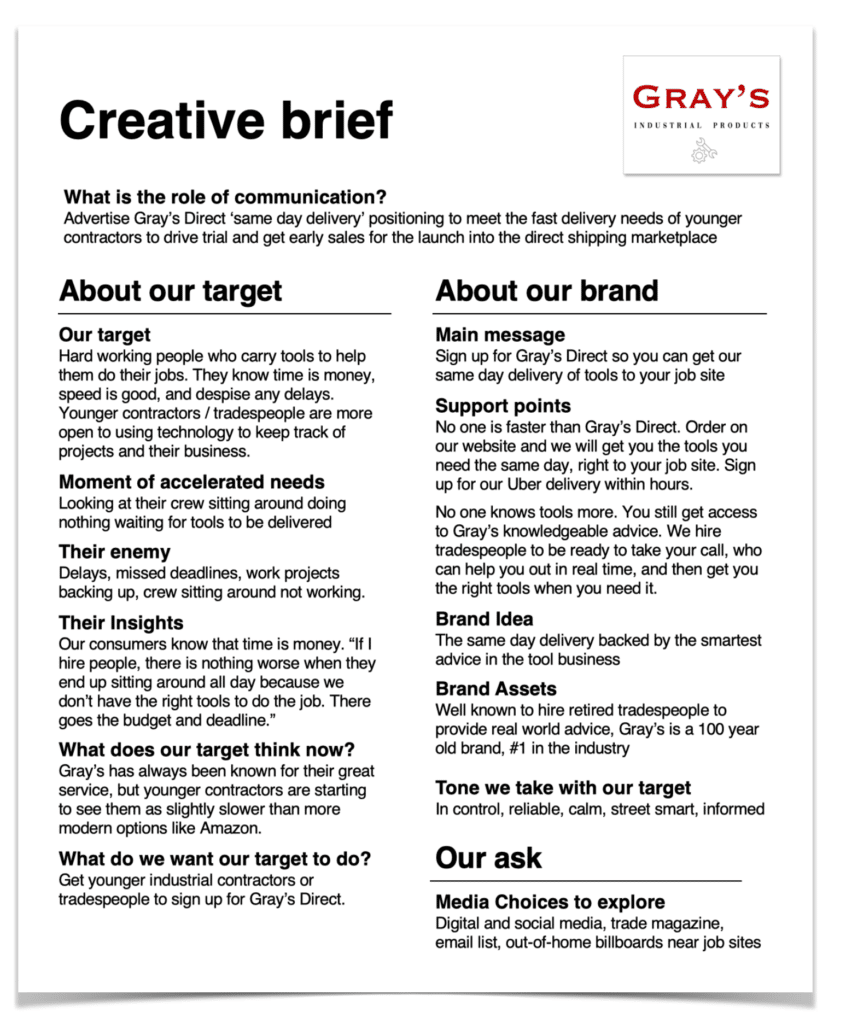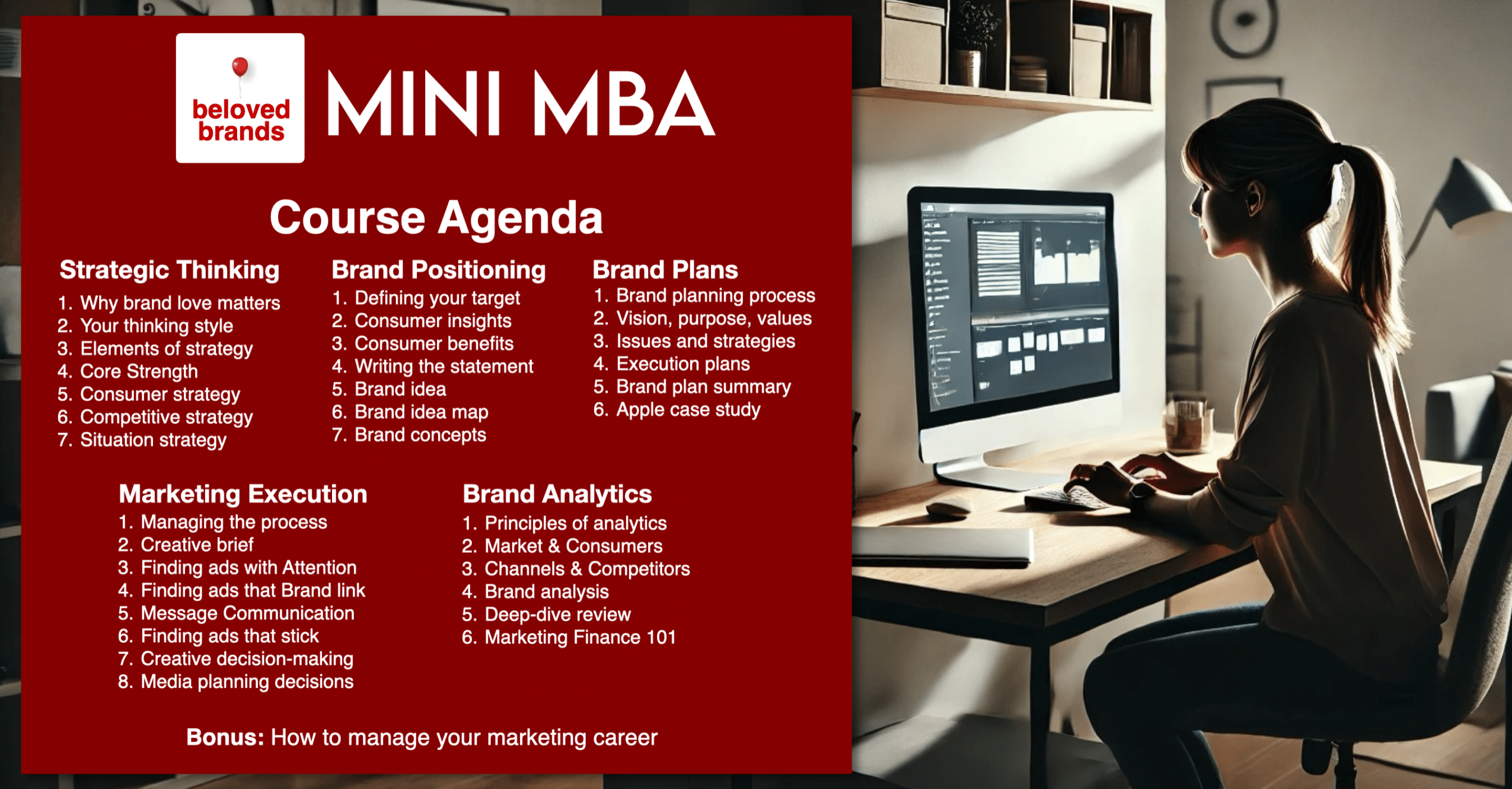If you write a lousy brief, you’ll get lousy advertising. It’s that simple. Garbage in, garbage out. Before you even think about briefing an agency, you need a rock-solid brand communications strategy—your brand positioning, brand idea, and brand plan should be locked in. The brief isn’t just a formality; it’s the bridge between strategy and execution. In this post, I break down how to write a killer creative brief, packed with creative brief examples and a creative brief template to get you started. If you want better ads, it starts here. It also serves as a Marketing Brief.
Here’s where too many marketers screw up: they give up too much control over strategy and then wonder why they don’t get the creative work they need. Your job as a marketing leader? Set a clear direction while giving creatives the freedom to do what they do best.
By the end of this article, you will have a deeper understanding of the components of a successful creative brief, which will elevate your marketing skills. And for those looking for even more in-depth guidance, I invite you to check out my Beloved Brands book.
What makes a great Creative Brief
Make the tough decisions to narrow the brief down to:
- One strategic objective
- One tightly defined consumer target
- One desired consumer response
- One main message
- Two reasons to believe.
Whenever I do training on how to write a creative brief, I meet resistance when I show people that list. You should see the resistance that your 8-page brief will meet.
Are you not seeing high quality briefs from your team?
If you are frustrated at the quality of the creative briefs you are seeing, it is likely impacting the output of the marketing communications on your brand. While you might have smart people on your team, if they have not been trained in marketing fundamentals, you will never see them reach their potential. With our Beloved Brands marketing training, your team will make smarter decisions and produce exceptional work that drives business growth. Our brand management training teaches the marketing skills to help your people gain the confidence they need to reach their full potential.
We also provide customized training, which allows you to tailor the training to the needs of your team. Graham Robertson brings a wealth of real-world marketing experience, having led many of the world’s best brands. Whether you’re looking to build a strong marketing team or develop your current team’s skills, Beloved Brands can help. Our training will give your team the tools and knowledge to drive smarter work and business growth. We teach how to write a creative brief with plenty of creative brief examples and a template for a creative brief.
Creative Brief checklist
To illustrate, click on the Creative Brief Checklist to zoom in. It also serves as a Marketing Brief.
Video - The 3 biggest flaws that wreck Creative Brief in 60 seconds
1️⃣ Objectives Overload
- When a brief has too many objectives, it dilutes the focus. Remember, clarity is power!
2️⃣ Lacking Insight
- Your target market is at the heart of any campaign. If the brief doesn’t delve deep enough into understanding them, you’re shooting in the dark.
3️⃣ Message Mayhem
- Bombarding with too many messages can be overwhelming. Keep it concise and impactful!
Our Creative Brief Template
I will dissect the creative brief with a line-by-line review to demonstrate examples of smart and bad creative briefs. Moreover, I will use some real case studies of bad briefs I have seen over the years to show you what not to do. I will use some of the principles I discussed to show you a smarter brief.
While each line in the brief has a role to play, the brief should have a natural flow. Similar to how we describe your brand plan as flowing like an orchestra arrangement when any line of the creative brief feels like it is playing the wrong note, it will stand out like a complete misfit.
The good and bad of Creative Briefs, for each line
1. Why are we advertising?
A bad brief has an unfocused objective:
- Drive trial of Gray’s Cookies, steal market share from mainstream competitors while getting current users to use Gray’s more often.
A smart brief has a focused objective:
- Drive trial of Gray’s Cookies, using the positioning of “The good tasting healthy cookie.”
Smart briefs start with one very clear objective, while bad briefs try to accomplish too many things at once.
If you get this line wrong, it can destroy the entire brief. With the creative brief example above, the smart brief narrows the decision to one objective (drive trial). A clear objective helps steer the direction for the rest of the brief. The bad brief makes the mistake of trying two things simultaneously.
Too many brands put “drive penetration and usage frequency” at the top of the brief. It is a sign of a lazy mind. Do you realize how different these two strategies are? Can you see how much you will drain your resources when you try to do both with the same ad?
These two strategies have two separate targets, two different brand messages, and potentially two different media plans. Your agency will divide the brief in half and return with one ad to drive penetration and another to drive usage frequency. As a result, you will pick your brand strategy based on which ad you like best.
One objective
If your brand has an issue with both penetration and usage, I recommend you write two separate creative briefs, with two independent projects, budgets, and media plans. From a brand plan viewpoint, I would also recommend you stagger these two strategies into different fiscal years to ensure you are not just dividing your limited resources and doing a poor job with both strategies.
Do you want more people to eat or the same amount of people to eat more? Pick one.
Penetration vs. usage frequency
A penetration strategy gets someone new with minimal experience with your brand to consider dropping their current brand to try you once and see if they will like it. That will take a lot of hard work.
A usage frequency strategy gets someone already familiar with your brand, and you have to convince them to change their behavior about your brand. They will have to change their current life routine or substitute your brand with a higher share of occasions.
Pick one strategy, not two
2. Who are we talking to?
A bad brief has an unfocused target:
- 18-65 years old, including current consumers, new consumers, and employees. They shop at grocery, drug, and mass retailers. They like cookies and eat 14.7 cookies a month.
A smart brief has a focused and well-defined target bulls-eye:
- “Proactive Preventers.” Suburban working moms, 35-40, willing to do whatever it takes to stay healthy. They run, work out, and eat right. For them, food is a stress reliever and an escape. Even for people who watch what they eat, there is still guilt when they cheat.
One of the most significant correlations with brand success is for consumers to playback and feel, “This brand is for me.” You can only achieve that by speaking directly with a precise, tight bullseye consumer target.
A smart brief uses a combination of demographics, behaviors, and attitudes and links how a cookie could fit into other parts of their healthy lifestyle. These details paint a complete picture of who we are talking to. In the bad, unfocused creative brief above, the target is pretty much everyone, so it will be hard for anyone to feel the advertising is speaking directly to them.
Beloved Brands Marketing Training
To view, use the arrows to see our Beloved Brands Marketing Training program video.
It's time to elevate your marketing team's performance with our Beloved Brands Marketing Training program.
Our marketing training makes your marketers smarter with brand analytics, strategic thinking, brand positioning, brand plans, and marketing execution.
3. What’s the consumer enemy we are fighting?
A bad brief has a business problem as the lead:
- Gray’s market share is still relatively small, held back by low awareness and trial. Product usage is not on par with the category.
A smart brief has a clearly stated consumer problem:
- Consumers struggle to fight off the temptation of cookies and feel guilty when they cheat.
The brief should reflect a consumer problem, not a business problem related to how consumers buy your brand. Think back to the target market chapter and use your consumers’ pain point or enemy, which torments them daily. Think of how your brand will battle that enemy on behalf of your consumers.
In the creative brief example above, the consumer’s enemies are “temptation and guilt.” Putting an emotional enemy in your brief allows the creative process to get into the emotional space right away. That is much more powerful than a functional problem such as losing weight or reducing calories.
In the bad brief example above, focusing on function rather than emotion is a classic flaw of leading with a business-driven problem about a brand’s problem with consumers.
4. Consumer insights
A bad brief has data over insights:
- Gray’s product taste drives high trial (50%) compared to other new launches (32%). Consumers use Gray’s 9.8 times per month compared to the category leader at 18.3 times per month.
A smart brief has deep, rich insights:
- Once consumers cheat on their diet, it puts their whole willpower at risk. They keep cheating. “Once I give in to a cookie, I can’t stop myself. They just taste too good. It puts my diet at risk of collapsing. I feel guilty. However, I can’t stop myself from cheating again.”
The creative brief example above uses Consumer Insights to go deep to gain an understanding and build a story through the voice of the consumer. It captures their inner thoughts, uses their own word choices, and expresses their feelings.
In the bad brief, there are no real insights. It is just a bunch of data points, without any depth of explanation or story. It will be hard for the creative team to write an engaging story with stats.

5. What does our consumer think now?
A bad brief provides data only, without a well-drawn conclusion:
- Gray’s only has 35% awareness and 9% penetration. Over 42% of consumers say they like the taste. However, consumers only eat Gray’s 3.6x per month.
A smart brief defines where consumers currently are with the brand:
- Gray’s Cookies have achieved a small growing base of brand fans, but most consumers remain unfamiliar and have yet to try Gray’s. Those who love Gray’s, describe it as “equally good on health and taste.”
You can use the brand love curve from our consumer strategy work to capture how consumers feel about your brand. Use the analytics from brand funnel analysis, the voice of consumer (VOC), market share data, loyalty data, and net promoter scores to determine where your brand sits on the curve.
The bad brief above just throws out random statistics; it fails to turn the data into stories that form a meaningful analysis. The smart brief draws an honest conclusion that your brand is at the unfamiliar/indifferent stage for most consumers. The statement also sheds light on what the few who love the brand say about it, suggesting what might motivate others.
To illustrate, click on the Consumer Brand Strategy to zoom in.
6. What do we want consumers to do?
A bad brief tries to trigger too many responses:
- We want consumers to THINK Gray’s Cookies are unique, to get consumers to FEEL they can stay in control, and then we want them to TRY Gray’s and see if they like them.
A smart brief focuses on the desired response that comes from the strategic objective:
- Get consumers to TRY Gray’s, believing the great taste will win them.
To illustrate, click on the Creative Brief desired response. This helps you learn how to write a Creative Brief
The bad brief above sets up an unrealistic attempt to get consumers to think, feel, and try – and all-in-one ad. The smart brief narrows the focus to drive trial, which aligns with the strategic objective of the brand plan. Too many marketers already know what they want to say before they even know the response they want from their consumers. Start with the desired response, which comes from your brand plan, and only then can you decide what to say to achieve that response.
7. Tone we will take with our consumers
A bad brief uses clichés that are all over the emotional map:
- Optimistic, smart, down-to-earth, trusted, popular, and yet friendly.
A smart brief focuses on the emotional zones your brand is trying to win:
- A safe choice to stay in control. An honest and down-to-earth option.
With Gray’s Cookies, the two emotional zones the brand positioning focuses on are “stay in control” and “I feel good about myself.” The related support words, including safe, honest, and down-to-earth, can help define your brand’s ideal emotional tone and manner. The bad brief is all over the map with emotions. Half the briefs I see seem to contain “smart, trusted, reliable, and friendly.” It has almost become clichés without thought.

To illustrate, click on the emotional zones to zoom in. It also serves as a Marketing Brief.
Read our story on how emotional advertising tightens the bond and grows your brand.
8. What should we tell consumers? (Main message)
A bad brief tries to communicate too many things at once:
- Gray’s Cookies are the perfect modern cookie, only 100 calories and less than 2g of fat. For those looking to lose weight, the American Dietitian’s recommend adding Gray’s to your diet. You can find Gray’s at all leading grocery stores.
A smart brief focuses on one main message, bringing the consumer benefit to life:
- Try Gray’s Cookies, the great-tasting cookie without any guilt.
The smart brief above narrows down to one thing: the brand idea of “great taste without the guilt.” The bad brief has a laundry list of seven unrelated messages. Most are just product features instead of the primary consumer benefit. It is a marketing myth to believe that if you tell the consumer many things, at least they will hear something. If you tell consumers too many messages, they will just shut you out and not listen to anything you say.
9. Why should consumers believe us?
A bad brief lists random claims about your brand:
- Gray’s Cookies are the cookies recommended by doctors and pharmacists. Plenty of before and after photos and consumer comments. Over 70% of consumers prefer Gray’s to Dad’s. Gray’s cookies have been made in America since 1963, containing all-natural ingredients. No one beats Gray’s for fiber content.
A smart brief uses the support points to close off lingering gaps:
- In blind taste tests, Gray’s Cookies matched market leaders on taste but only has 100 calories and 2g of fat. In a 12-week study, consumers using Gray’s once a night as a dessert lost 5 pounds.
Only use support points to close off any potential gaps in your logic. Listen to consumers for possible doubts they may have relative to your main message. Based on Logic 101, you can win any argument using two premise points to conclude. The same should hold true for a brand. Force yourself to use a maximum of two support points.
The smart brief above focuses on two support points that back up your main message. The bad creative brief example throws out random claims that have nothing to do with the main message.
10. Brand idea
A bad brief throws out random features to anyone:
- Anyone could love Gray’s Cookies, premium cookies that taste great. Over 70% of consumers prefer Gray’s to Dad’s. Gray’s cookies come from a homemade recipe. Doctors and pharmacists recommend them. You can buy them at your local grocery store.
A smart brief uses the brand idea that organizes everything we do:
- Gray’s are the best tasting yet guilt-free pleasure, so you can stay in control of your health and mind.
The smart creative brief uses the brand idea that drives everything we do. The bad creative brief example above targets everyone and lists random features and claims. However, it does not contain any consumer benefits. If you only tell consumers what you do, not what they get, you risk leaving it up to their interpretation.
11. Brand Assets
A bad brief throws out random features and ideas to control the creative:
- Avoid humor, as a sarcastic tone will not work with our target market. Real customer testimonials supported before/after with our 90-day guarantee tagged on. Use our celebrity spokesperson. Increase credibility by having set in a pharmacy. Add our AMA doctor recommendation seal.
A smart brief uses distinctive creative and strategic assets to build behind:
- Story of our New England family recipe, our signature stack of beautiful cookies, “More Cookie. Less Guilt.”
The smart brief builds creative and strategic assets. Stay confident that you have written such a great brief that you do not need to control the creative outcome.
12. Media choices
A bad brief uses too many media choices, especially early in the process:
- TV, 30-seconds, and 15-seconds. Include 5-second tag for promotions. Print includes magazine and newspaper. Need separate display headers for Walmart. Need to use Facebook, Twitter, and Instagram. Must be able to use video on our website and YouTube channel.
A smart brief provides a range to see what the creative looks like first:
- The main creative will be a 30-second TV ad, supported by event signage and in-store display. Carry the idea into digital and social media and build a microsite.
At the briefing stage, you might have ideas about what type of media you want to use, but it is difficult to know the ideal media until you see the creative idea. At this point, provide a potential media guideline with a lead media option and possible media choices to support.
The unfocused bad creative brief example above offers a laundry list of media choices, which will only spread your limited resources so thin that nothing will have the desired impact you hope for. When you try to be everywhere, you might end up nowhere.
To illustrate, click on the Media Options to zoom in. It also serves as a Marketing Brief.
Here’s a simple way to ensure your creative team covers almost every potential media choice. Ask to see each creative idea presented through a 30-second TV script, a simple billboard, and a long-copy print ad. This process allows you to see how each creative idea plays out on almost any media option before you start to narrow down your media planning. Asking for TV, billboard, and a long-copy print for each creative idea will allow you to imagine how it might look using any of the 12 potential media choices.
Mandatories
A good brief gives freedom to the creative team to explore:
- The line: “best tasting yet guilt-free pleasure” is on our packaging. 25% of the print must carry the Whole Foods logo as part of our listing agreement. Include our legal disclaimer on the taste test and 12-week study.
A smart brief has very few mandatories with none of them steering the creative outcome. Stay confident that you have written such a great brief, that you do not need to control the creative outcome. Give some creative freedom to allow your agency the opportunity to look at the best way to express and deliver your strategy.
The bad creative brief example uses mandatories to steer the creative outcome with a prescriptive list that backs the agency into a creative corner. With this bad brief, for the agency to tick off each mandatory, they will create a messy, ugly “Frankenstein” ad to piece everything together.
You can follow our Creative brief template
Take everything you know about the brand and strategically desire, and distill it into one page. We have a second post on the Creative Brief that dissects the good and bad versions of each line of the brief. Click here to read more: How to write a Creative Brief that steers and inspires your team.
Creative Brief template
To illustrate, click on the Creative Brief template to zoom in. It also serves as a Marketing Brief.
Mini creative brief template
Going too fast sometimes takes too long. With the explosion of media options, timing is everything. Unfortunately, there are too many “phone call briefs” happening. Even worse, no brief at all. Accordingly, when in a rush, use our mini creative brief.
To illustrate, click on the mini Creative Brief template to zoom in. It also serves as a Marketing Brief.
Media brief template
Our media brief template allows you to also brief your media team. The template follows the same pattern as our creative brief example. Read about how to build a media strategy.
Creative Brief examples
To illustrate, click on any of the template for creative brief below.
To illustrate, click on the Creative Brief example. It also serves as a Marketing Brief.
To illustrate, click on the Creative Brief example. It also serves as a Marketing Brief.
Mini Brief
With social media, digital advertising, and search media, marketing is moving faster than ever. You still need a creative brief but might need to try our mini creative brief. We are seeing things speed up, with opportunities coming to brand leaders who need quick decisions and execution. This mini brief is part of our template for creative brief.
How to write a Creative Brief - Frequently Asked Questions
What is a creative brief?
The creative brief bridges the strategy in a marketing plan and the marketing execution. You can use a creative brief for any marketing communications. Advertising. Packaging. Websites. Digital Media. Retail merchandising. Social Media. Events. Sales Material. The role of the creative brief is to set the parameters for the creative people. It guides them on the strategy, main messages, and media choices.
What should a creative brief include?
A creative brief should include a strategic objective statement at the top. Match up the desired consumer response to the objective. Then, define the target market. Add flavor with consumer insights. In terms of the message, include the main benefit and up to two main reasons for believing. We go through the good and bad of a creative brief, line by line, with examples. It also serves as a Marketing Brief.
What are the most important parts of a creative brief?
The most important parts of a creative brief are the target, objective, and main message. When learning how to write a creative brief, focus on who you are talking to, what you are trying to do, and what you are trying to say. Once you have those decisions, writing the rest of the Creative Brief is easier.
Who writes the creative brief?
When I was in marketing, the strategic planner at the creative agency wrote the creative brief. That worked when a brand had one main agency. Now, a brand might work with multiple agencies. First, a brand might have an agency for traditional advertising. Second, a brand would have an agency-specific to digital or social media. Third, there are agencies for retail merchandising, PR, or professional marketing.
Finally, the brand might have a design agency that looks at logos and the look and feel of the brand. With the proliferation of agencies, the brand manager often writes the creative brief. Some might refer to this as a marketing brief. And the agency would then write its own version of a creative brief. They will put more inspirational thinking into the creative brief when this happens. It’s ok to have two briefs as long as the brand manager knows which one they will use to make their advertising decisions.





